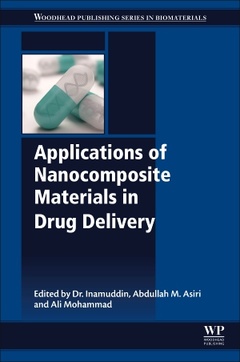Description
Applications of Nanocomposite Materials in Drug Delivery
Woodhead Publishing Series in Biomaterials Series
Coordinators: Inamuddin , Asiri Abdullah M., Mohammad Ali
Language: English
Subjects for Applications of Nanocomposite Materials in Drug Delivery:
Keywords
3D scaffolds; Active target; Administration route; Alginate; Alginates; Alternative magnetic field; Amide linkage; Anticancer drugs; Applications; Aptamer; Area under the curve; Avidin; Bio-nanocomposites; Bioavailability; Biocompatibility; Biodegradable; Biomaterials; Biomedical; Biomedical applications; Bionanocomposites; Biotin; Cancer; Cancer diagnostic; Cancer theranostic; Cancer therapy; Carbon nanotube; Cardiac regeneration; Cell therapy; Cellulose nanofiber; Ceramic; Chitosan; Chitosan-based nanocomposites; Clay; Colon cancer; Colon-specific; Composites; Controlled drug delivery; Controlled release; Conventional synthesis; Cyclodextrin; Deformable vesicles; Dendrimer; Dentistry; Diagnosis; Doxorubin; Doxycycline hyclate; Drug; Drug carriers; Drug delivery; Drug delivery system; Drug delivery systems; Drug interaction; Drug nanocrystals; Drug release; Drug stability; Drugs; Electrospinning; Electrospun fiber mats; Enforcing agent; FDA; Folic acid; Gene; Gold nanoparticles; Graphene; Growth factors; Hyaluronic acid; Hydrogel; Hydroxyapatite; In situ; In vitro; Infectious diseases; Injectable; Inorganic materials; Intraocular pressure; Ionotropically cross-linking; Iron oxide; Kaolin; Ligands; Liposome; Liposomes; Liquid crystalline; Magnetic; Magnetic nanoparticle; Magnetic resonance imaging; Magnetism; Mesoporous silica nanoparticles; Metal-organic frameworks; Micelle; Microemulsifying systems; Microemulsions; Microneedle; Microwave; Montmorillonite; Montmorillonite clay; Multiaxial electrospinning; Multiple sclerosis; Nano-MOFs; Nano-fillers; Nanobubble; Nanocapsule
990 p. · 15x22.8 cm · Paperback
Description
/li>Contents
/li>Readership
/li>Biography
/li>Comment
/li>
Applications of Nanocomposite in Drug Delivery discusses and explores the applications of nanocomposites in the area of drug delivery. Starting with a scientific understanding of drug delivery fundamentals, the book explores the utility of nanocomposites in the area of controlled, transdermal, osteo-articular tuberculosis and stimulus sensitive drug delivery applications. The book intricately details and discusses a variety of methods for their preparation, while also highlighting specific applications of nanocomposites in targeted drug delivery.
2. Applications of cellulose nanofibrils in drug delivery
3. Avidin-based nanoparticles in drug delivery
4. Carbon based polymer for drug delivery
5. Carbon nanotube for targeted drug delivery
6. carbon nanotubes
7. Chitosan-based nanocomposites for drug delivery
8. Chitosan nano composites for drug delivery and gene delivery
9. Conjugated polymers in drug delivery: Research trend
10. Cyclodextrin based Nanosponges in Drug Delivery and Cancer Therapeutics: New Perspectives for Old Problems
11. Development of injectable in-situ gelling systems of Doxycycline hyclate for controlled drug delivery system
12. Drug delivery for cardiac regeneration
13. Drug Delivery: Present past and future of medicine
14. Drug nanocrystals: Present past and future
15. Electrospun matrices for localised drug delivery: current technologies and selected biomedical applications
16. Electrospun nanocomposites for targeted drug delivery
17. Hydrogel nanocomposite for controlled drug release
18. Mesoporous nanomaterials as carriers in drug delivery
19. Metal organic frameworks for drug delivery
20. Metal-ferrite nanocomposites for targeted drug delivery
21. Microwave synthesised nanocomposites for enhancing oral bioavailability of drugs
22. Montmorillonite clay nanocomposites for drug delivery
23. Nanocomposite for cancer targeted drug delivery
24. Applications of Nanocomposite Materials in the Delivery of Anticancer Drugs
25. Nanocomposite for transdermal drug delivery
26. Nanocomposite microemulsions for drug delivery
27. Nanocomposites for diagnosis and treatment of multiple sclerosis
28. Nanocomposites Scaffolds for Tissue Engineering; Preparation, Properties and Applications
29. Nanoemulsion in Drug Delivery
30. Okra gum-alginate composites for controlled drug releasing delivery
31. Oral colon cancer targeting by chitosan nanocomposites
32. Phase transition microemulsions as drug delivery systems
33. Polymer-ceramic nanocomposites for controlled drug delivery
34. Potential of nanoparticles as drug delivery system for cancer treatment
35. Stimuli-responsive nanocomposites for drug delivery
36. Superparamagnetic
37. Superparamagnetic nanoparticles for drug delivery
38. Tumor-targeted drug delivery by nanocomposites
39. Vesicular nanostructures for transdermal delivery
The book targets scientists, engineers, industrial experts, Ph.D. students and master students in the field of biochemical engineering, materials chemistry, medical industry like dentistry & orthopaedic and pharmaceutical chemistry
Prof. Abdullah M. Asiri is the Head of the Chemistry Department at King Abdulaziz University since October 2009 and he is the founder and the Director of the Center of Excellence for Advanced Materials Research (CEAMR) since 2010 till date. He is the Professor of Organic Photochemistry. His research interest covers color chemistry, synthesis of novel photochromic and thermochromic systems, synthesis of novel coloring matters and dyeing of textiles, materials chemistry, nanochemistry and nanotechnology, polymers and plastics. A major achievement of Prof. Asiri is the discovery of tribochromic compounds, a class of compounds which change from slightly or colorless to deep colored when subjected to small pressure or when grind. This discovery was introduced to the scientific community as a new terminology published by IUPAC in 2000. This discovery was awarded a patent from European Patent office and from UK patent. He is also a member of the Editorial Board of various journals of international repute. He is the Vice- President of Saudi C
- Discusses nanocomposite and nanotechnology for drug delivery
- Outlines the mechanisms involved in targeted drug delivery using nanocomposites
- Includes synthesis methods for nanocomposites used in controlled drug delivery
- Lists various applications of nanocomposites in drug delivery




